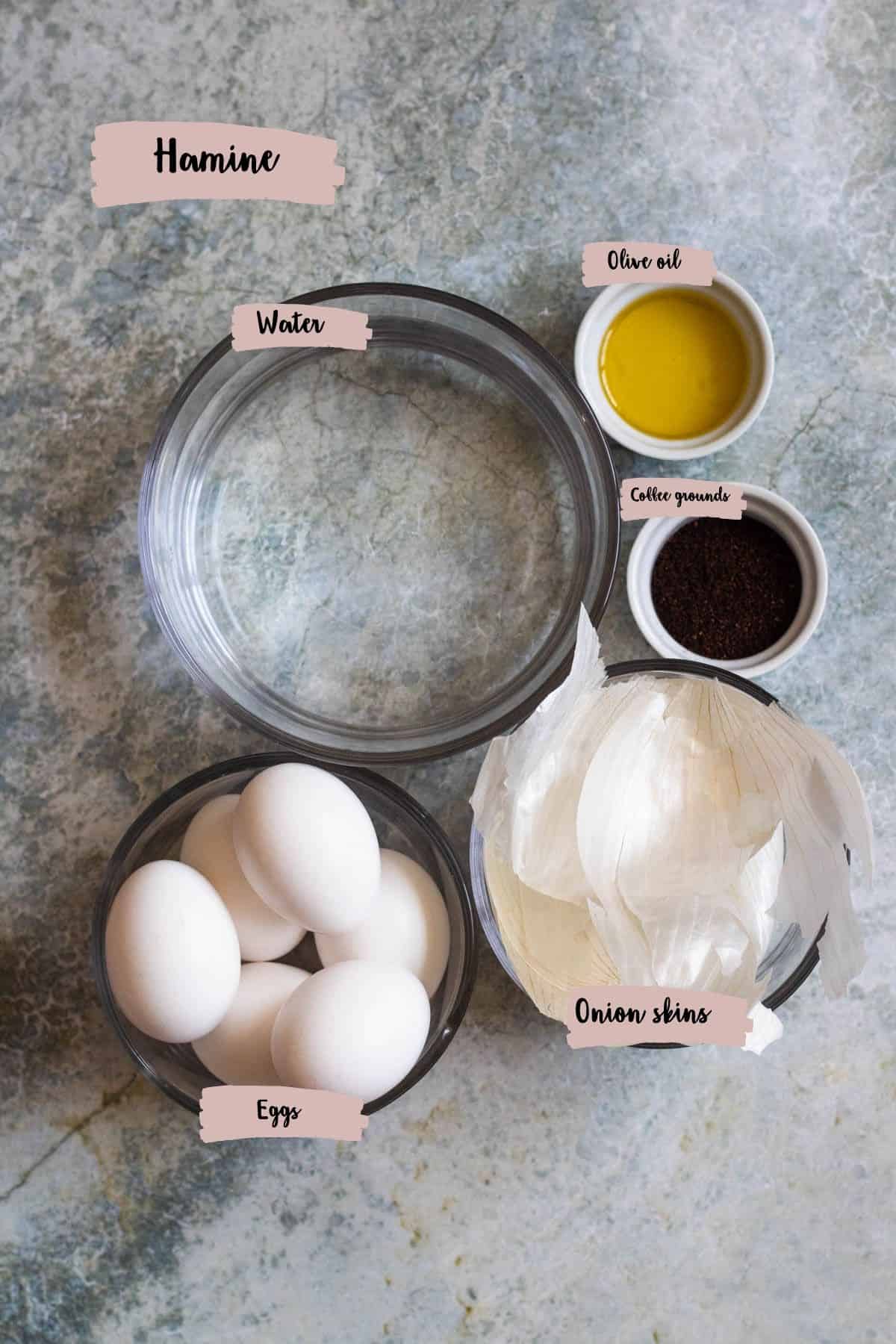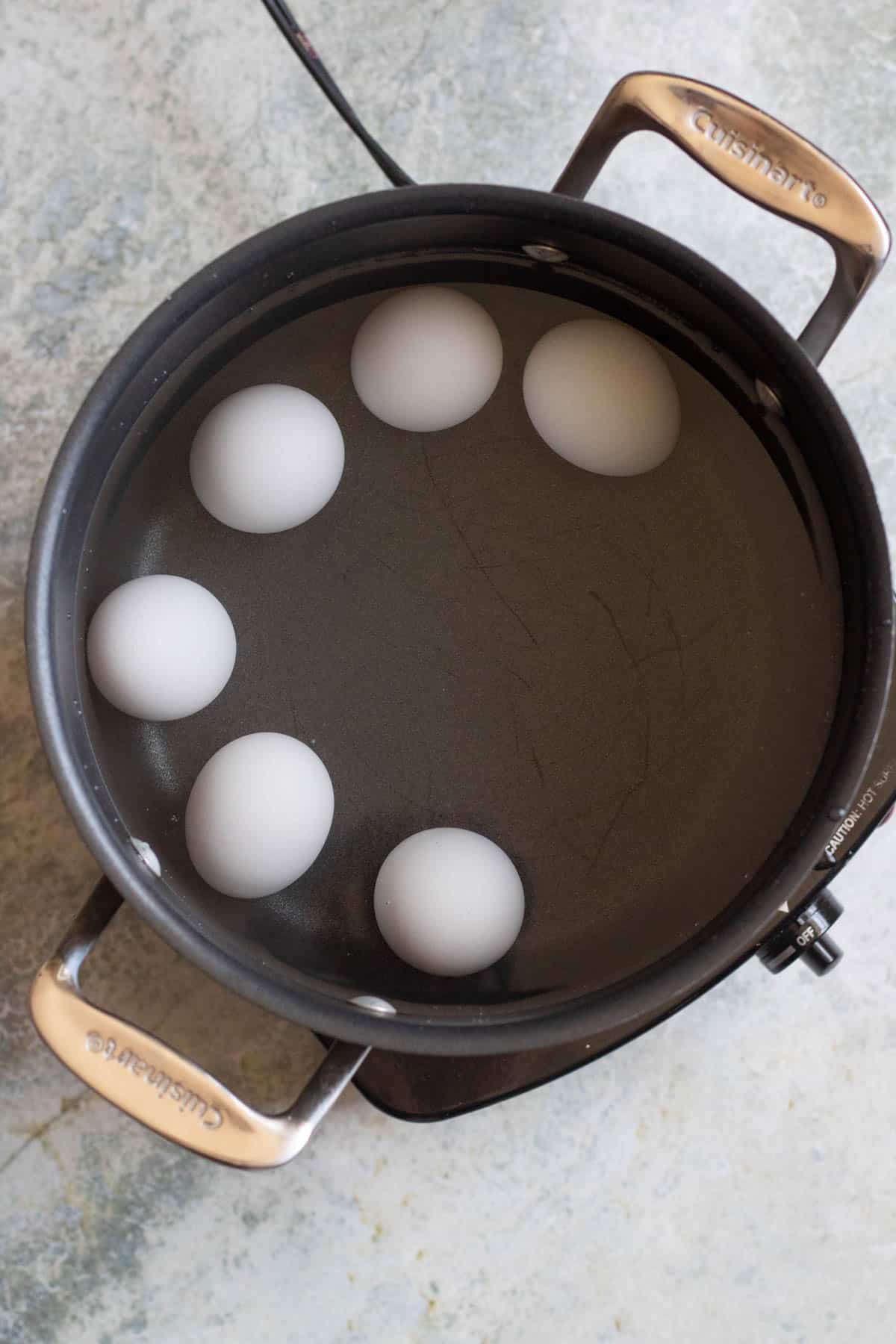Beid Hamine is a popular recipe enjoyed in Jewish tradition, and is made by boiling eggs for up to 10 hours in a broth made with onion skins. Coffee grounds give the eggs their characteristically beautiful brown color.
After 10 hours of cooking, the egg yolks of the beid hamine eggs are soft and, surprisingly, not dry! The taste is unique and interesting, and I think you’ll really like trying this interesting dish!

Hello Reader! I try my hardest to research recipes as best as I can before posting to ensure I am representing each culture correctly. If this recipe is from your country and I have made a mistake or you have suggestions for how to make it more authentic, I would love to hear! Please leave a comment below letting me know what should be different, and I will rework the recipe. It is always my intention to pay homage and respect to each cultural dish that I cook. Thanks for reading!
Recipe Origins
Hamine Eggs, or Beid Eggs, are eggs that are boiled for 10 hours. The result is a “browned” taste that is hard to describe but, as As Simple Vegetarian Dishes so truthfully put it, tastes similar to burnt popcorn.
Hamine eggs were popular in Shepardic Jewish communities. The eggs usually begin to be cooked on Friday night and are finished by Saturday morning, or Shabbat.
In certain Jewish subsects, the day of Shabbat is a holy day in which cooking is prohibited. Making the eggs Friday night into Saturday morning assured that there would be freshly cooked food to eat while still observing Shabbat.
These eggs are popular in many countries, including Greece, Spain, Turkey, Morocco, Tunisia, Egypt, Israel and more, though there are variations in the recipes that make them different from one another.
Other Cooking Methods
This recipe for hamine (as well as most modern recipes nowadays) calls for cooking Hamine on the stovetop. However, many years ago there were other methods to cooking these eggs!
In Spain (and still in Africa) the eggs were buried overnight in hot coals or hot ashes, which continued to cook them in a steady heat long after the household or community went to sleep.
It is also common to wrap the eggs in aluminum foil and bake them, or even to put them in a clay pot and bake them.
Why Make this Recipe
- Unique: It is so much fun to experiment with new food eaten around the world. Try something new today and make these Hamine Eggs!
- Hands Off: While the cook time seems like a long time, you don’t have to touch these eggs for hours. The hardest part of this recipe is simply adding everything into a pot.
- Appreciate Other Cultures: Maybe this is a dish you eat frequently, but for quite a few people, this dish will be a new experience! Experience and appreciate this Jewish food by trying it at home.
What Do I Need to Make this Recipe?
Ingredients
Here is a visual overview of the ingredients in the recipe. Scroll down to the recipe at the bottom for quantities.

- Eggs: Use brown eggs if you have them for a more vibrant color. White eggs will also work (this is what I used)
- Skin from 2 White Onions: Just use the skin. You can discard the onions, but you can also use them to make this Easy Pasta Sauce Recipe.
- Coffee Grounds: You can use any coffee grounds you have on hand. They are mostly for color, though they do affect the taste a bit.
Tools
- Large Pot + Lid
How to Make this Recipe
Step 1: Prepare the Eggs


Add the eggs into a large pot and cover with water. Add at least an extra 6 inches of water above the eggs so that the water does not evaporate out overnight
Add the coffee grounds, olive oil, and onion skins to the pot.
Step 2: Cook the Eggs

Add a lid onto the pot and bring the water to a boil. Once boiling, reduce to a simmer and allow to simmer, covered for 10 hours.
Peel and serve!
Expert Tips

- Many recipes call for boiling the eggs overnight, but I do not like keeping my boiler on while I’m sleeping. Instead I boiled them during the day and then kept the eggs in the fridge overnight until I was ready to eat them the next morning.
- Serve the eggs cooled
- It’s common to eat these eggs with hummus in Israel
- Serve these eggs in salad, by themselves, or on sandwiches for a great treat. It’s also common in stews
- Keep the temperature of the water at a simmer to make soft eggs
Recipe FAQs

Yes, you can cook the eggs in a slow cooker or an electric pressure cooker, though I have not tried these methods myself!
You can keep leftovers in the fridge. Wait to peel the eggs until right before you are ready to eat them. They should stay good in the fridge for up to 5 days.
Did you enjoy this recipe for Hamine? If so, make sure to check out these other recipes I picked out just for you:
- Easy Egg Biryani (Hyderabadi Biryani)
- Gondo Datschi (Eggs with Goat Cheese and Herbs)
- Deep Fried Hard Boiled Eggs
- Vegetable and Lobster Egg Scramble

Hamine
Equipment
- Pot(s)
Ingredients
- 6 eggs
- Water
- 1 tbsp coffee grounds
- 1 tbsp olive oil
- Skin from 2 white onions
Instructions
- Add the eggs into a large pot and cover with water. Add at least an extra 6 inches of water above the eggs so that the water does not evaporate out overnight
- Add the coffee grounds, olive oil, and onion skins to the pot.
- Add a lid onto the pot and bring the water to a boil. Once boiling, reduce to a simmer and allow to simmer, covered for 10 hours.
- Peel and serve!
Video
Notes
- Eggs: Use brown eggs if you have them for a more vibrant color. White eggs will also work (this is what I used)
- Skin from 2 White Onions: Just use the skin. You can discard the onions, but you can also use them to make this Easy Pasta Sauce Recipe.
- Coffee Grounds: You can use any coffee grounds you have on hand. They are mostly for color, though they do affect the taste a bit.
- Many recipes call for boiling the eggs overnight, but I do not like keeping my boiler on while I’m sleeping. Instead I boiled them during the day and then kept the eggs in the fridge overnight until I was ready to eat them the next morning.
- Serve the eggs cooled
- It’s common to eat these eggs with hummus in Israel
- Serve these eggs in salad, by themselves, or on sandwiches for a great treat. It’s also common in stews
- Keep the temperature of the water at a simmer to make soft eggs








Leave a Reply